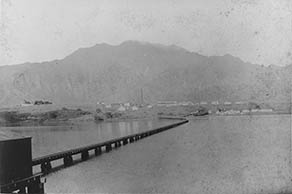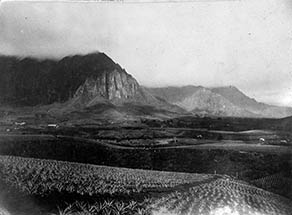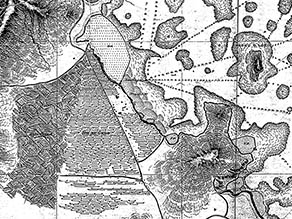 |
 |
 |
 |
||||||
|
|
|
|
|
|
|
|
|
|
 |
|
 |
|||||||
 |

“When the plantations came in, they needed water,” Kalani says, “so they set about to divert streams and clear the land, the natural forest of ‘ōhi‘a and whatever, in order to put in sugarcane first, and after that other other crops like coffee and what not. So it really did change the environment. And Hawaiians were decreasing in population because of the impact of foreign diseases and also the urban drift, so they were leaving the land. 
“Title to the land disappeared if they weren’t paying the taxes. And so we had adverse possession and all. So the plantation era had a massive impact on Hawaiian land, because there were so many plantations put in. And of course they needed workers for their plantations. That really changed the human landscape of Hawai‘i. So cheap foreign plantation laborers were imported. Some stayed afer their contracts were up, took Hawaiian wives, raised families.” “The Japanese came starting in 1868 to work sugar plantations,” Lilikalā points out. “Sugar didn’t work here in Ko‘olaupoko. Pineapple came in about 1906. James Dole—a missionary’s son—cut down all of the forests from the bottom of the pali all the way out to Kahalu‘u, and they planted pineapple. Hawaiians told them ‘Don’t do that because it’s going to rot. It rains so much in this area.’ Sure enough, the whole place went broke.” “Sugar was number one,” Kalani adds, "pineapples were later of course, a luxury crop product, big on Moloka‘i. And then rice, rice growing. So where formerly taro was grown, those were converted over to rice fields. And then the imported Chinese laborers were happy to grow rice, and Hawai‘i became a big rice-eating society.” Ian talks about his Portuguese ancestors arriving in the 1800s. 
“A lot of the lo‘i were turned into rice fields because there was a high demand for rice,” Lilikalā explains, “and you could make more money than from planting taro. So the people started planting rice instead of taro. A lot of Chinese and Japanese were raising rice. So if Hawaiians owned the taro fields, they would lease it out for rice production.” “Rice was down the lo‘i," Alice recalls. "Rice, pineapple, and something else was growing there. My mom said the rice took, but not too well.” Livestock grazing in Ko‘oloaupoko was taking place by the late 1840s. Rev. Benjamin Parker noted about 600 cattle, some sheep, and many goats in the district, and that they were quickly increasing in number. By the early 1900s, Kāne‘ohe Ranch covered 12,000 acres, stretching from Waimānalo to Hau‘ula, with 2000 head of cattle. There were also two ranches on Mōkapu penninsula, the one on He‘eia side owned by Robert Wyllie Davis. Cattle were either directly responsible for the destruction of heiau and other cultural sites through trampling and scattering of the rocks, or indirectly by the heiau being dismantled and the rocks used for cattle pens. “Urban drift meant that Hawaiians were, because of their financial state, forced to live in ghettos, urban ghettos,” Kalani continues. “So by the beginning of the 1900s, Hawaiian ali‘i and inheritors of the throne, especially Prince Jonah Kūhiō Kalaniana‘ole, realized, ‘Hey! To save our people, we've got to get them back on the land.’ And so he, as the second Territorial delegate to Congress, was able to get through Congress the Hawaiian Homestead Act around 1920. “Then land was made available for Hawaiian settlement. But they didn’t farm, they couldn’t farm unless there was water. So not many of them became actual farmers, though they were living on the land. But they would lease it out to the plantation or whomever. So for the most part then, taro growing really diminished to the point where only a few areas were kept up as taro-growing areas. Taro was raised by Chinese or Japanese or by others as a commercial commodity. Hawaiians were looking for work in the cities, stevedoring, ultimately heavy work and road construction, road gangs, and then later on as policemen, firemen and that sort of thing. You still find them in those occupations where a lot of physical strength is needed.” “He‘eia is mostly Kamehameha Schools land,” Lilikalā states. “I bought this property from Kamehameha Schools 15 years ago, 17 years ago I think it was. Kamehameha owns from the mountain to the sea. If you go up to Waipao, or Ha‘ikū, or ‘Ioleka‘a, that’s all Kamehameha Schools land, all the way down to the ocean. It’s all subject to state regulation, and Army Corps of Engineers, and federal stuff. "A law that was passed in, I want to say 1978 or 1980, that forced lease-to-fee conversion. It forced Kamehameha Schools to sell off a lot of its property that it had developed as residential property, but they still own Windward Mall. They still own the shopping center across, I think. But they had to sell off little residential places. “They still own the wetlands down below. Kamehameha Schools owns about 18 ahupua‘a out of the 1,600 ahupua‘a throughout the archipelago. Most of them—600—are around Hawai‘i Island. Kamehameha Schools owns different ahupua‘a that Ruth Ke‘e-liko-lani was able to get.”
|
 |
|
 |
Over the next century, changes that were affecting the rest of the Hawaiian Islands gradually reached He‘eia. These changes are part of the memories of He‘eia.
|
 |
||
 |
|
 |
||

|
 |
||||
|
||||
Copyright 2019 Pacific Worlds & Associates • Usage Policy • Webmaster |
||||


